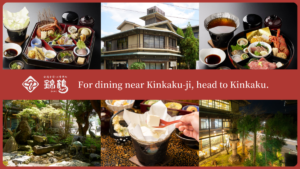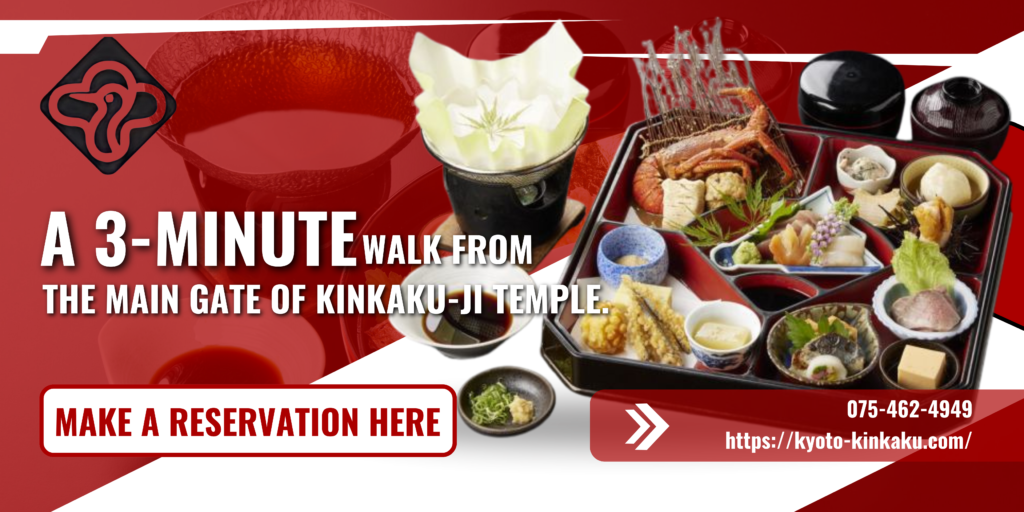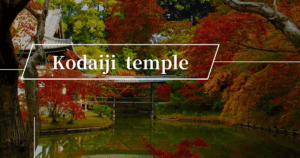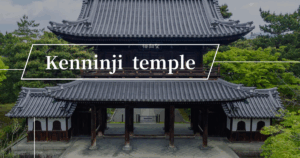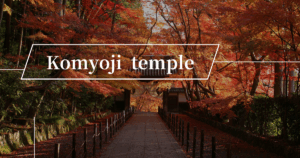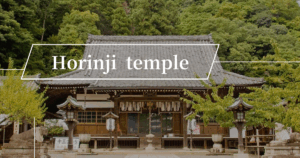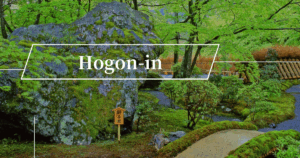Sanjusangendo Temple stands in Higashiyama, Kyoto.
Once you open the door, you will be taken aback by the sight of 1,001 Thousand-Armed Kannon statues lined up in an orderly fashion.
The temple’s principal image, the Thousand-Armed Kannon Seated Statue, a National Treasure, is centered around brilliantly colored statues of the wind god and thunder god, as well as 28 statues of guardian deities created by master craftsmen of the Kamakura period.
The sight of these structures, which have continued to watch over us quietly for over 800 years since their construction, encapsulates the profound beauty and faith of Japan.
In this article, we’ll take a closer look at Sanjusangendo, including its history, highlights, and access.
What kind of place is Sanjusangendo?
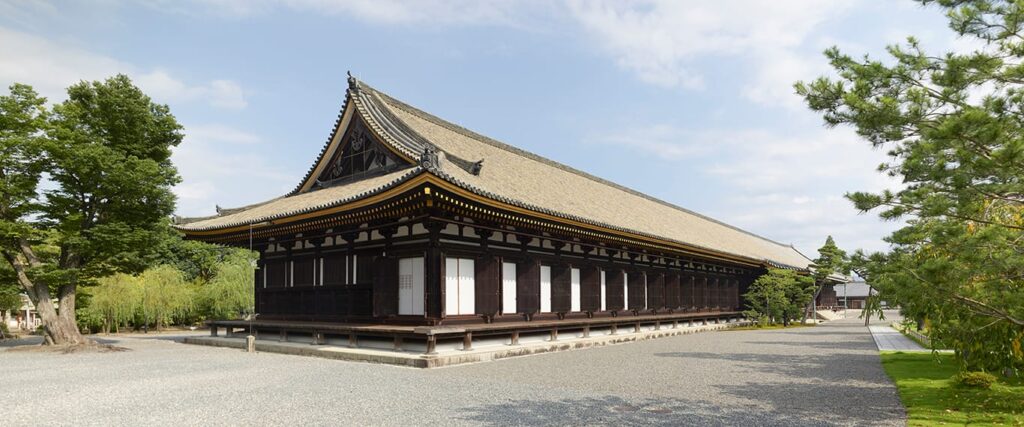
Sanjusangendo, whose official name is Rengeoin Main Hall, is a Tendai sect temple located in Higashiyama Ward, Kyoto City.
This is a historic structure that was founded by Emperor Goshirakawa in 1164 and rebuilt in 1266 .
The name “Sanjusangen-do” comes from the fact that the main hall has 33 spaces between its pillars.
The number “33” refers to the 33 forms in which Kannon Bodhisattva appears to save all living beings.
The building’s most notable features are its overwhelming size and the numerous Buddhist statues housed within.
The main hall is long and narrow from east to west, and at approximately 120 meters in length, it is the longest wooden building in Japan.
Inside, there are 1,000 life-size standing statues of the Thousand-Armed Kannon lined up in neat rows, centered around the principal image, the National Treasure “Seated Thousand-Armed Kannon,” as well as a total of 1,031 Buddhist statues, including statues of the wind gods and thunder gods and the 28 deities.
Every January, a traditional archery tournament called “Toshiya” is held here, and it is a famous spot representing Kyoto that attracts many tourists.
The History of Sanjusangendo
Sanjusangendo is a temple representing Kyoto with a history of over 800 years.
Officially known as the Rengeoin Main Hall, this structure has endured many historical changes and has been preserved to this day.
We will explore the temple’s long history and introduce its cultural and religious value.
The Founding and the Thoughts of Emperor Goshirakawa
Sanjusangendo was founded in 1164 (the second year of the Chokan era) at the request of Emperor Goshirakawa.
It was originally the main hall of a temple called Rengeoin, which was built on the east side of the Emperor’s Rokujo Palace.
It is said that the Emperor built the temple, enshrining the Thousand-Armed Kannon as its principal image, in the hope of attaining paradise for himself.
The original building was smaller than it is today, but it is said to have already housed over a thousand Kannon statues.
The building was strongly influenced by the Emperor’s deep Buddhist faith and the Pure Land Buddhism of the time, and was also a symbol of Buddhist culture in aristocratic society at the end of the Heian period.
History of destruction and reconstruction
In 1249 (the first year of the Kencho era), just over 100 years after its construction, Sanjusangendo was destroyed by fire during a war.
At that time, Japan was in a period of transition to a samurai society, and there was a lot of political turmoil.
However, at the request of Kujo Michiie, it was rebuilt in its current form in 1266 (Bun’ei 3).
The rebuilt hall had a width of 33 bays (approximately 60m) and a depth of 7 bays (approximately 12m), and had a unique shape that was long from east to west.
The 1,001 standing Thousand-Armed Kannon statues and the principal image, a seated Thousand-Armed Kannon statue, that were enshrined at this time are precious cultural assets that convey to the present day the outstanding skills of the Kamakura period Buddhist sculptors.
Preservation since the modern era and its value as a cultural asset
From the Edo period through the Meiji period onwards, Sanjusangendo came to be recognised as a national cultural asset.
In 1897 (Meiji 30), the main hall was designated a special protected structure under the Ancient Shrines and Temples Preservation Law, and in 1951 it was designated a national treasure.
Additionally, the Buddha statues within the hall are protected as national treasures and important cultural properties.
Since the 2000s, large-scale preservation and repair work has been carried out, including strengthening the building’s earthquake resistance and replacing the roof.
Today, it is an important tourist spot in Kyoto, attracting approximately one million visitors per year, and is also carefully preserved as a valuable cultural heritage that conveys the essence of Japanese wooden architectural techniques and Buddhist art to the present day.
Highlights of Sanjusangendo Temple
Sanjusangendo continues to fascinate visitors with its overwhelming number of Buddhist statues and magnificent architecture.
This temple, which has many national treasures and important cultural properties, is the epitome of traditional Japanese beauty and faith.
Here we will introduce the main attractions of Sanjusangendo Temple that even first-time visitors should pay attention to.
Highlights of Sanjusangendo Temple
- A large group of standing Thousand-Armed Kannon statues
- National Treasure: Thousand-Armed Kannon Seated Statue
- The 28 deities and statues of the wind and thunder gods
A large group of standing Thousand-Armed Kannon statues
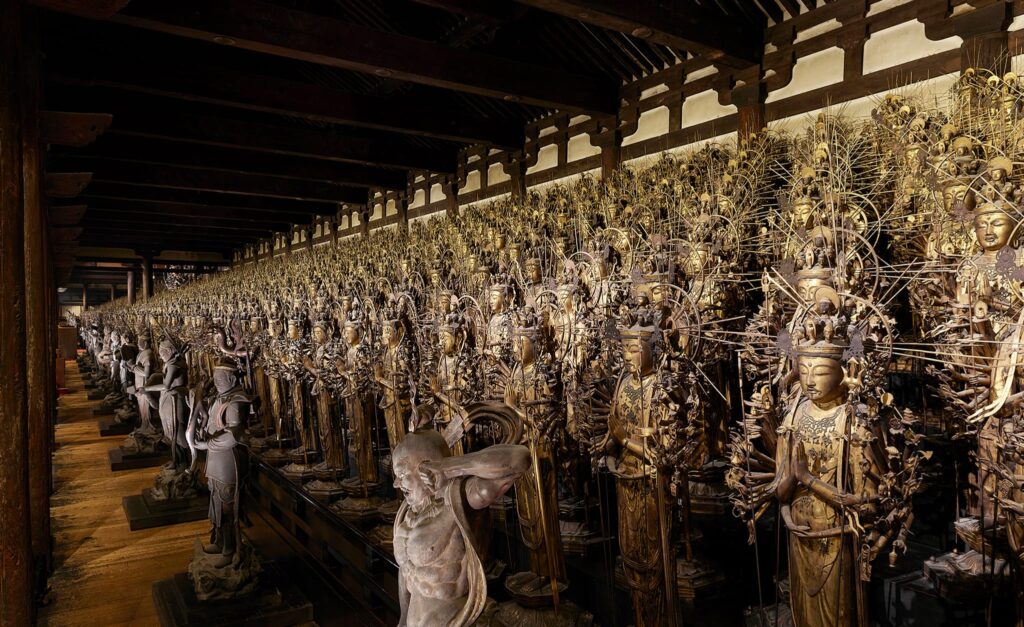
The greatest attraction of Sanjusangendo is undoubtedly the 1,000 standing Thousand-Armed Kannon statues lined up in an orderly fashion within the 120-meter long, narrow hall.
These were produced over a period of 70 years, from the end of the Fujiwara period to the early Kamakura period, and are all designated as Important Cultural Properties.
Each statue is life-size (approximately 1.6m) and crafted with exquisite detail.
What’s particularly noteworthy is that all 1,000 figures have slightly different expressions and appearances.
The Thousand-Armed Kannon standing statue, called “Sanjusangendo-gata” and placed in the center, is slightly larger than the others and is worshiped as the representative of the 1,000 statues.
One way to enjoy the temple is to walk around the hall and observe the different expressions on each Buddha statue.
National Treasure: Thousand-Armed Kannon Seated Statue
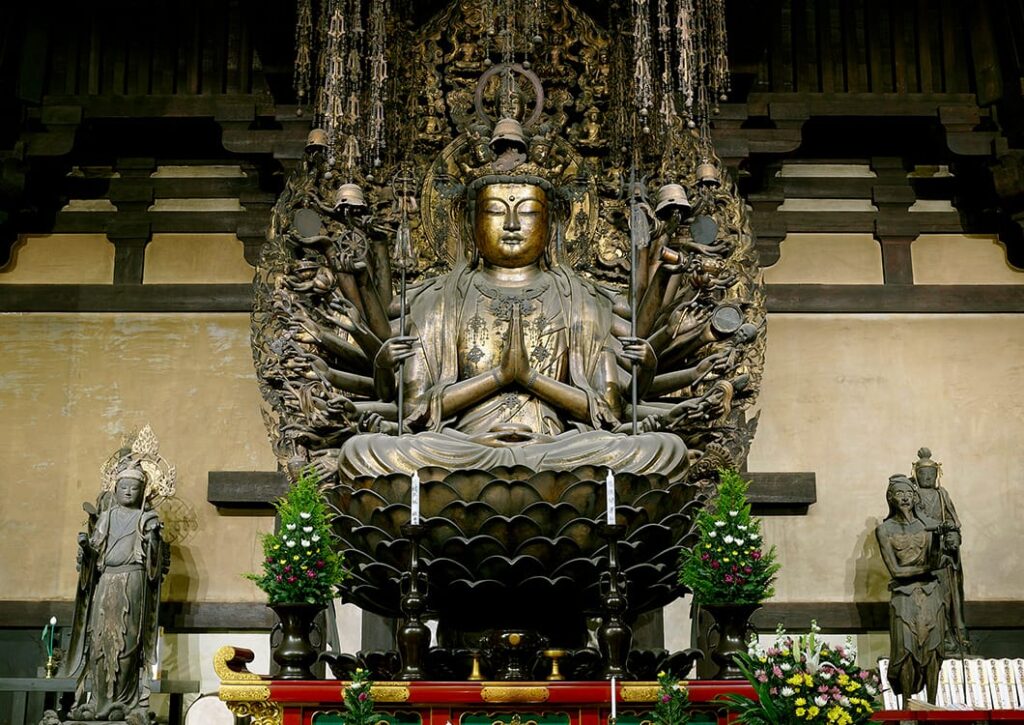
The principal image, a seated Thousand-Armed Kannon statue, enshrined in the center of the hall, is a national treasure that is considered one of the greatest masterpieces of Buddhist sculpture in Japan.
Created by the Buddhist sculptor Tankei in 1254 during the late Heian period, this statue boasts an imposing appearance, standing approximately 3.3 meters tall.
Theoretically, the Thousand-Armed Kannon has 1,000 arms, but in reality it has 42 arms holding various objects, each symbolizing a different salvation.
It has eleven small faces (eleven faces) on its head, and its appearance as it watches over all living beings looking in different directions is truly majestic.
Additionally, statues of the wind god and thunder god are placed around the statue, highlighting the sacredness of the Thousand-Armed Kannon.
This principal image is usually enshrined quietly in darkness, but its presence permeates the entire hall.
The 28 deities and statues of the wind and thunder gods
In addition to the Thousand-Armed Kannon statue, Sanjusangendo has a group of other must-see Buddhist statues.
Representative of these are the 28 deities who protect the principal image, as well as the statues of the wind god and thunder god.
The Twenty-Eight Deities are guardian deities from Hindu mythology who were adopted into Buddhism, and each has a unique appearance.
The angry-looking Ashura statue and the elephant-headed Vajrayana Bodhisattva are particularly impressive.
These are said to have been made by members of the school of Unkei, a famous Kamakura period craftsman, and their realistic expression and dynamic form overwhelm viewers.
Additionally, the statues of the wind god and thunder god, placed on either side of the principal image, are popular for their vivid colors and lively expressions.
These statues are highly regarded not just as guardian deities, but as works of art that demonstrate the highest standard of Japanese sculpture at the time.
What is the best season to visit Sanjusangendo Temple?
Sanjusangendo is a tourist spot that can be enjoyed all year round, but there are seasons when it is especially recommended.
First, in January in winter, a traditional event called “Toshiya” is held, during which special viewing of the interior of the hall is possible.
In spring, the temple grounds are beautifully colored during cherry blossom season, but the best time to visit is from late April to early May when it is less crowded .
The fresh greenery is beautiful in June, in early summer, and the light illuminating the Buddha statues is soft on sunny days before the rainy season begins.
The autumn leaves change color from late October to mid-November, so we recommend taking a stroll around the surrounding Higashiyama area as well.
Also, if you visit early in the morning on a weekday when there are fewer tourists, you can take your time admiring the Buddha statues in a quiet atmosphere.
Each season has its own unique charm, so it’s a good idea to choose a time to visit that suits your preferences.
Access to Sanjusangendo Temple
Sanjusangendo Temple is located in Higashiyama Ward, Kyoto City, and can be reached by various means of transportation.
It is located in a relatively easy-to-access location from Kyoto Station, the base for sightseeing in Kyoto, as well as other tourist attractions.
Here we will introduce specific access methods from major locations.
Access from Kyoto Station
There are several ways to get to Sanjusangendo Temple from Kyoto Station.
The most common way is to take a city bus, take bus numbers 100, 206, or 208 from bus stop A1 in front of Kyoto Station, and get off at the “Hakubutsukan Sanjusangendo-mae” stop; the tour is right in front of you (time required: about 15 minutes, fare: 230 yen).
If you take a taxi, it will take about 10 minutes and cost around 1,000 yen.
You can also walk there in about 25 minutes (about 2 km), and the easiest route to follow is to head east along Shichijo-dori.
It is a popular tourist course heading towards Higashiyama from Kyoto Station, and many people visit it together with Tofuku-ji Temple and Chishaku-in Temple.
Access from Kinkakuji Temple
The most convenient way to get from Kinkakuji to Sanjusangendo is to take a city bus.
Take city bus numbers 101, 102, 204, 205, etc. from the Kinkakuji-mae bus stop and get off at Shijo Kawaramachi or Shijo Karasuma.
From there, change to Kyoto City Bus number 207 and get off at Higashiyama Shichijo or Museum Sanjusangendo-mae. It is then a short walk away (total travel time approximately 50 minutes, fare 460 yen).
If you take a direct taxi, it will take about 25 minutes and cost around 2,500 yen.
Additionally, a one-day pass (700 yen) is economical for sightseeing within Kyoto city.
If you plan to visit Kinkaku-ji and Sanjusangendo on the same day, you can make the most of your time by visiting tourist spots in the Higashiyama area, such as Kiyomizu-dera and Gion, in between.
Sanjusangendo Temple admission fees and opening hours
Below is a table summarizing basic information about Sanjusangendo.
| 項目 | content |
|---|---|
| Visiting hours | 8:00~17:00(4月~11月) 9:00~16:00(12月~3月) |
| Admission fee | Adults (high school students and above): 600 yen Junior high school students: 400 yen Elementary school students: 300 yen * Group discounts available (for groups of 30 or more) |
| Estimated travel time | About 30 minutes to 1 hour |
| location | 657 Sanjusangendo-mawaricho, Higashiyama Ward, Kyoto City |
| Nearest bus stop | Get off at the bus stop “Sanjusangendo Museum” |
| Nearest station | Approximately 7 minutes walk from Keihan “Shichijo Station” Approximately 20 minutes walk from JR “Kyoto Station” |
Recommended spots around Sanjusangendo Temple
When you visit Sanjusangendo, we also recommend touring the other fascinating temples and shrines in the Higashiyama area.
The Higashiyama area is one of Kyoto’s most famous tourist destinations, and is home to many historic temples.
There are many sights within walking distance, allowing you to experience Kyoto’s history and culture efficiently.
Here we will introduce three particularly recommended nearby temples, shrines, and Buddhist temples.
Chishakuin
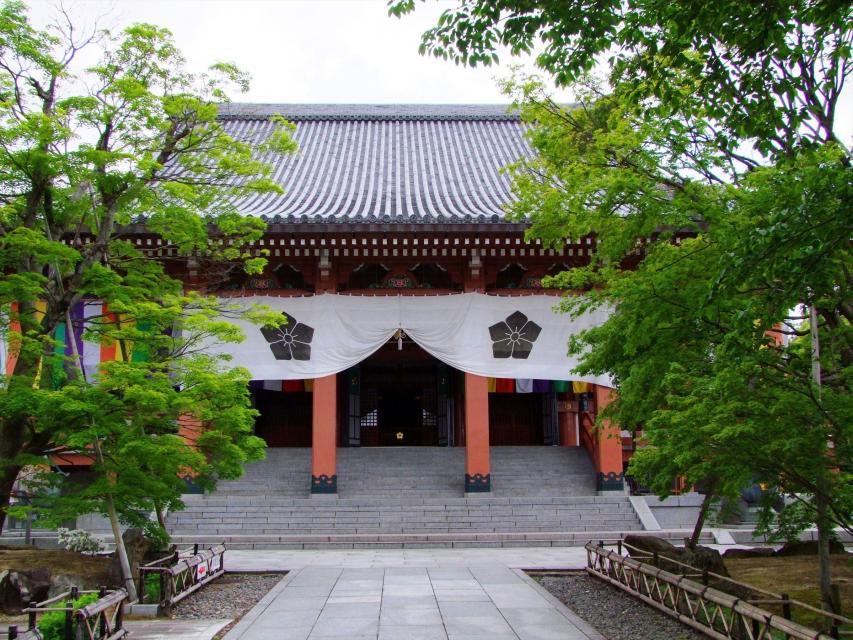
Chishaku-in Temple, located about a 5-minute walk from Sanjusangendo Temple, is the head temple of the Chizan school of Shingon Buddhism.
This historic temple was founded in 1601 and was built to commemorate the soul of Toyotomi Hideyoshi.
Highlights include the reception hall known as the “Sanjusangendo-gata” style, which is a designated national treasure, and the beautiful sliding screen paintings by the Kano school .
In particular, the Eight Views of Xiaoxiang is considered one of the greatest masterpieces in the history of Japanese art.
It is also known as a famous spot for weeping cherry blossoms in spring and rhododendrons in early summer, and since there are relatively few tourists, you can spend a blissful moment gazing at the Japanese garden in a quiet atmosphere.
Despite being home to many national treasures and important cultural properties, it is a hidden gem and is especially recommended for those who want to avoid the crowds and enjoy Kyoto’s temple architecture and beautiful gardens.
Tofukuji Temple
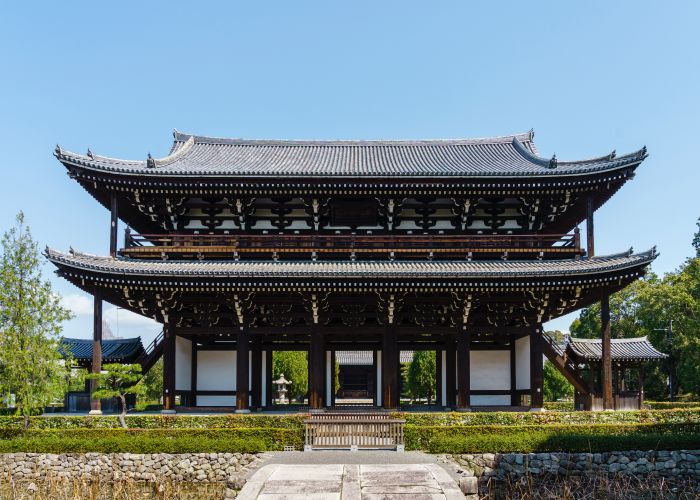
Tofukuji Temple, located about a 15-minute walk or a few minutes by city bus from Sanjusangendo Temple, is the head temple of the Tofukuji school of the Rinzai sect of Buddhism, founded in the Kamakura period.
It is especially known as a famous spot for viewing autumn leaves, and in autumn the view of the valley covered in autumn leaves from Tsutenkyo Bridge is spectacular.
The temple grounds are vast and contain several national treasures and important cultural properties, and the Hojo Garden is a magnificent garden on all four sides that is said to have been designed by Muso Soseki, a Zen monk representative of the Kamakura period.
The Toji (toilet) is known as a valuable piece of architecture that retains the oldest Zen temple style in Japan.
This is a temple where you can enjoy the beauty of every season: the fresh greenery of spring, the green leaves of summer, the autumn foliage, and the snowy scenery of winter. We recommend visiting early in the morning when it is less crowded.
This is one of Kyoto’s most famous temples, where you can enjoy the solemn atmosphere unique to a Zen temple and the beauty of a Japanese garden.
Kenninji Temple
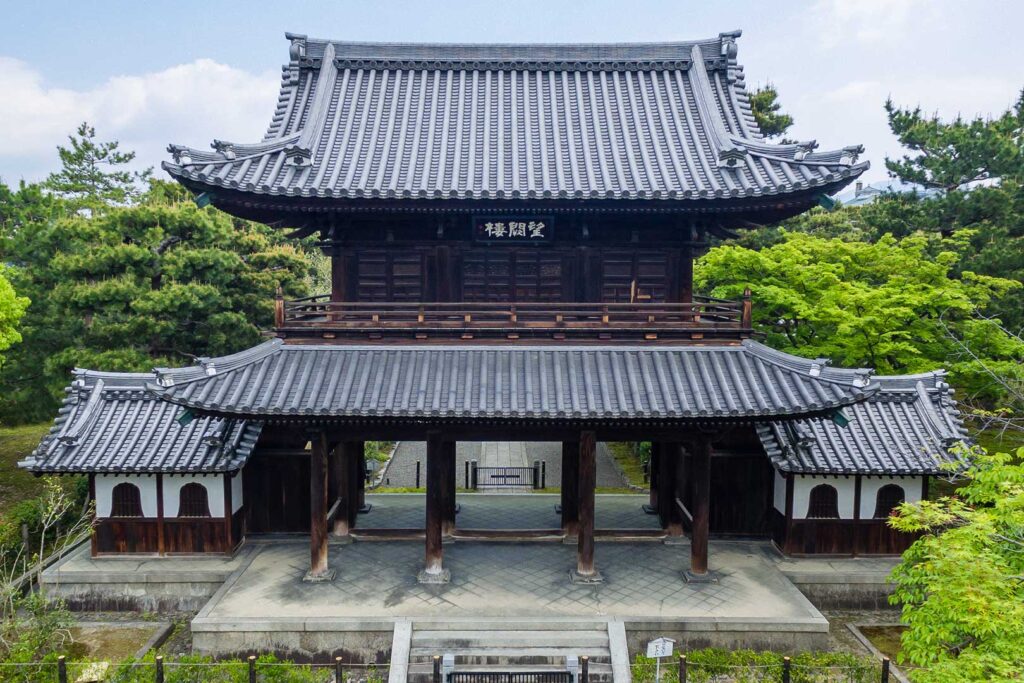
Kenninji Temple, located about 10 minutes by city bus or 20 minutes on foot from Sanjusangendo Temple, is known as the oldest Zen temple in Japan.
Founded in 1202 by Zen master Eisai, it is the head temple of the Kenninji school of the Rinzai sect.
The replica of the National Treasure “Wind Gods and Thunder Gods Screen” painted in the Hojo and the ceiling painting “Two Dragons” are spectacular.
Another highlight is the modern dry landscape garden known as the “Circle, Triangle, and Square Garden.”
Although it is located next to Gion and in a bustling tourist area, once you step inside the temple grounds you will find yourself enveloped in a space of silence.
Although it is located in the heart of Kyoto city, it is a rare place where you can experience the deep world of Zen, and with easy access from Sanjusangendo Temple, it is the perfect temple to end your tour of Higashiyama.
FAQs about Sanjusangendo Temple
summary
Sanjusangendo, a temple that is steeped in history and faith, has stood as one of Kyoto’s most famous temples for over 800 years.
Founded by a prayer by Emperor Goshirakawa, this temple has undergone many changes and is now home to an impressive collection of Buddhist statues, including 1,000 standing statues of the Thousand-Armed Kannon.
Sanjusangendo Temple is beautiful in every season and has a variety of attractions, so by visiting it along with the nearby Tofuku-ji Temple and Chishaku-in Temple, you can fully enjoy the charm of Kyoto.
Come experience a journey into the profound beauty and faith of Japan in this space where time continues to quietly tick away.
